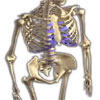Whole-body-vibration not effective for prevention of bone loss
Whole-body-vibration, a popular exercise which uses a vibrating platform, is sometimes advertised as being able to boost bone density. However, a one-year-study on healthy postmenopausal women has shown that it has no such effect.
The study entitled, “Effects of 12 Months of Whole-Body Vibration (WBV) on Bone Density and Structure in Postmenopausal Women: A Randomized Controlled Trial”, is published in the November 15, 2011 issue of the Annals of Internal Medicine. This study was led by University Health Network (UHN) researchers, Drs. Angela Cheung, Shabbir Alibhai and Luba Slatkovska (lead author), who conducted this as part of her doctoral thesis.
“Although researchers are seeking alternatives to time-consuming exercise to improve bone density, the results of this study suggest this specific therapy is not effective in improving bone density,” said Dr. Angela Cheung, Director of the Osteoporosis Program at UHN, Director of the Centre of Excellence in Skeletal Health Assessment (CESHA), Lillian Love Chair in Women’s Health, and Associate Professor, University of Toronto. “Women would be farther ahead in making sure that they are exercising regularly and eating nutritious foods.”
About one in two women after the age of 50 will have a fracture in their lifetime that is related to osteoporosis. Osteoporosis is a condition that causes bones to become brittle and porous, decreasing bone strength and density, thereby increasing the risk of fracture or breakage. The most common sites of osteoporotic fracture are the wrist, spine and hip.
WBV involves standing on a motor-driven, oscillating small platform, like a bathroom scale, which produces upward accelerations from the feet to the weight-bearing muscles and bones, reproducing pressure on the bones, much like weight-bearing exercises are designed to do. With very little effort, participants can simply stand on these moving platforms to allegedly achieve the benefits of more labourious and intense exercises.
Participants in the study were 202 healthy postmenopausal women, with a mean age of 60, who were not on any prescription bone medications. They were randomised into three separate arms of the clinical trial which included low magnitude (which mimics muscle contractions in activities such as walking) at either 30Hz or 90 Hz oscillations. They were asked to stand on the platform for 20 minutes daily at home for 12 months.
The control group was asked not to use WBV therapies. All women were provided calcium and vitamin D supplements at baseline and six months, so that their daily intakes approximated 1200 mg and 1000 IU, respectively.
At baseline and 12 months, bone structure and bone density were measured at the hip, and lumbar spine, using dual-energy X-ray absorptiometry, and at the forearm and lower leg using high-resolution peripheral quantitative computed tomography (CT scan), the most advanced imaging technology for measuring bone structure and density.
Twelve months of low-magnitude WBV at 90 and 30 Hz did not result in any significant changes in either bone density or bone structure in the participants as measured at the hip or lumbar spine, or lower leg or forearm, compared to those participants who did not do WBV.
The study concludes that low-magnitude WBV is not an effective therapy for the prevention of bone loss in postmenopausal women.
Instead, Dr. Cheung recommends that for women without osteoporosis, adequate calcium and vitamin D through diet and supplements, as well as weight-bearing exercises such as walking, dancing, or exercising with small weights, are better strategies for maintaining strong bones.
(Source: University Health Network (UHN): Annals of Internal Medicine)
More information
 | For more information on osteoporosis, including its effect on bones and the importance of nutrition and dairy, as well as some useful videos and tools, see Osteoporosis. |
Dates
Created by:

 Login
Login














